Soil Temperature and Corn Emergence
Crop Insights written by Ross Ennen, Sr. Research Associate, and Mark Jeschke, Ph.D., Agronomy Manager
4/16/2019
Crop Insights written by Ross Ennen, Sr. Research Associate, and Mark Jeschke, Ph.D., Agronomy Manager
4/16/2019
Successful corn emergence is a combination of three key factors – environment, genetics and seed quality (Figure 1). Hybrid genetics provide the basis for tolerance to cold stress. High seed quality helps ensure that the seed will perform up to its genetic ability. Pioneer brand corn products are selected to provide the best genetics for consistent performance of across a wide range of environments, and seed production practices are optimized for maximum quality. However, even with the best genetics and highest seed quality, environmental factors can still influence stand establishment. A combination of field- and lab-based research on the effects of stressful conditions on corn germination and emergence provides valuable insights which can help farmers make informed decisions and better manage their field operations to maximize stands.
This Crop Insights will discuss how the level and timing of cold stress affects seed germination and emergence and how farmers can mitigate these stresses when planting in challenging environments.
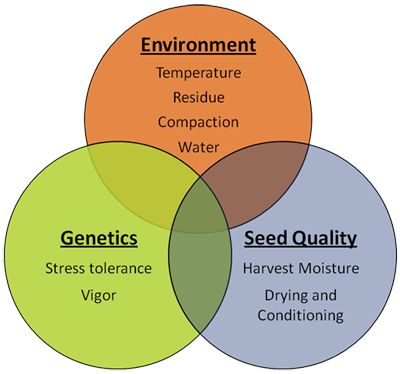
Figure 1. Some critical environmental, genetic and seed quality factors that affect stand establishment.
Corn is a warm season crop and grows best under warm conditions. In North America, early-season planting typically puts substantial stress on corn seedlings, especially if planting is followed by cold, wet weather. As planting has shifted earlier, the potential for cold soil at planting and cold, wet weather after planting has increased. In fact, it is not unusual for early-planted corn to remain in cold, saturated soil for two to three weeks or longer before emerging.
To illustrate the effects of temperature on corn growth, three hybrids of early, mid and late maturities were germinated in temperatures ranging from 59 to 95°F (15 to 35°C). Growth rates of both roots and shoots were measured. Both shoots and roots exhibited the fastest growth rate at 86°F (30°C) and continued to grow rapidly at 95°F (35°C), suggesting optimal seedling germination and emergence occurs at much higher soil temperatures than are common in most corn producing areas (Figure 2). It is generally recommended that farmers plant when soil temperatures are at or above 50°F. Farmers can expect much slower emergence and growth at the cool soil temperatures that are typical during corn planting in much of U.S. and Canada.
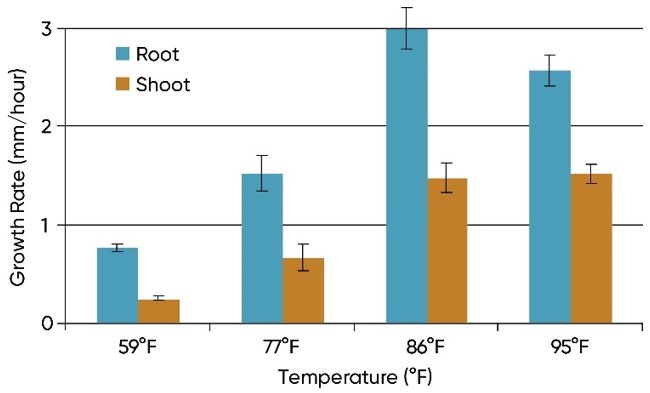
Figure 2. Average early root and shoot growth rates for three hybrids under four soil temperatures ranging from 59 to 95°F.
Spring soil temperatures can vary greatly year to year. Soil temperatures at planting in combination with near- to moderate-term weather trends have profound effects on the probability of establishing optimal stands and achieving maximum yields. Researchers recorded average soil temperatures at planting depth at several stress emergence research locations in 2018 (Figure 3).
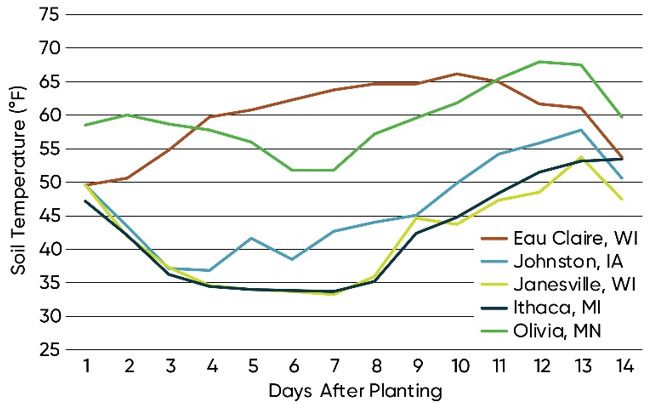
Figure 3. Average late-April soil temperatures recorded at 2-inch depth at several stress emergence testing locations.
At three research locations, soil temperature dropped well-below 50°F for a week or more after planting. Figure 4 illustrates the general relationship between soil temperature and stand establishment observed at these locations in 2018.
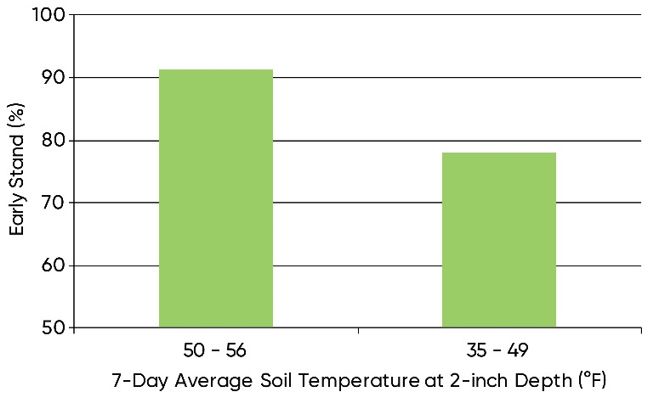
Figure 4. Relationship of soil temperature at planting depth (7-day average after planting) to final stand at stress emergence research locations in 2018.
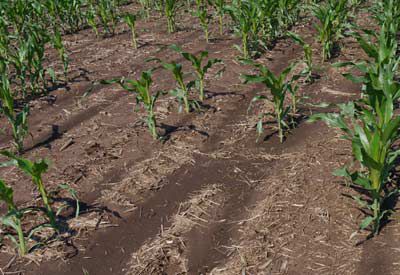
Low soil temperatures after planting greatly reduced stands at a stress emergence site near Eau Claire, WI, in 2011.
Pioneer® brand corn products are rated for stress emergence to help farmers manage early-season risk. Choosing hybrids with higher stress emergence scores can help reduce genetic vulnerability to stand loss due to cold soil temperatures. To generate stress emergence ratings, hybrids are tested over multiple years and environments beginning several years before commercialization. The goal is to generate data from many different types of early-season stress before assigning ratings.
Hybrids are tested in several early-planted field sites, including no-till and continuous corn locations. Testing sites are located in Minnesota, Wisconsin, Iowa, South Dakota, North Dakota, and Michigan and are chosen to reflect the various seedbed and environmental conditions likely to be experienced by farmers. For example, some eastern sites are characterized by extended cold, wet conditions that often persist into late spring and early summer, while northern and Midwestern sites are more likely to provide extreme day/night temperature fluctuations. These testing sites, with their diverse and unique conditions, provide a more thorough understanding of hybrid responses to early season stress. A typical testing site is characterized by large amounts of residue, cold soil (below 50ºF) at planting followed by cold rain or snow and emergence usually requiring two to three weeks.
Pioneer brand corn products are also tested in lab assays that simulate stressful field conditions. These tests, which have been validated by multi-year field trials, provide consistent and reproducible test conditions coupled with the flexibility of year-round testing. These lab assays are used to support hybrid advancement decisions and also to support breeding efforts to improve early season stress tolerance through marker-assisted selection.
In 2018, a wide range of stress emergence conditions and soil temperatures were observed in stress emergence field plots. To demonstrate how stress emergence ratings relate to stand establishment in the field, hybrids were grouped by “low stress emergence” – those with a stress emergence rating of 4, and “high stress emergence” - those with a stress emergence rating of 6.
The trials included 199 low stress emergence hybrids and 159 high stress emergence hybrids. Early stand counts for all hybrids within each group were averaged at each location. As stress level increased, both the low stress emergence and high stress emergence hybrids experienced stand reduction. However, the hybrids with a stress emergence score of 6 were able to maintain higher stands as compared to those with a low stress emergence score (Figure 5).
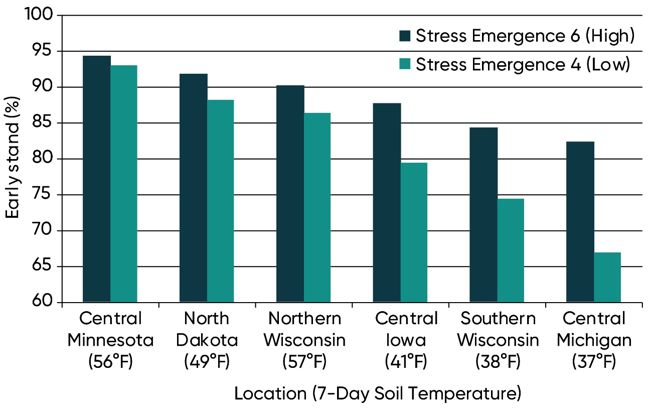
Figure 5. Average stand establishment for high and low stress emergence score hybrids in six stress emergence locations in 2018. Locations are sorted from least stressful (left) to most stressful (right) based on average early stand.
Early planting often exposes seeds to hydration with cold water, which can cause direct physical damage. When the dry seed imbibes cold water as a result of a cold rain or melting snow, imbibitional chilling injury may result. The cell membranes of the seed lack fluidity at low temperatures, and under these conditions, the hydration process can result in rupture of the membranes. Cell contents then leak through this rupture and provide a food source for invading pathogens. Cold water can similarly affect seedling structures as they begin to emerge. The degree of damage ranges from seed death to abnormalities such as corkscrews or fused coleoptiles (Figure 6).
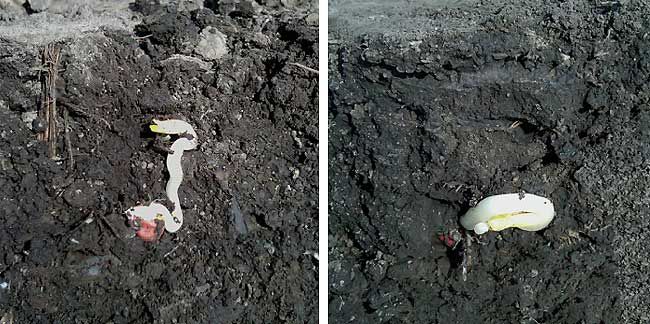
Figure 6. Abnormal mesocotyl and coleoptile development due to cold stress in an early-planted Illinois field.
To help understand the importance of the timing of cold stress, two hybrids with stress emergence scores of 4 (below average) and 7 (above average) were allowed to germinate in rolled towels for 0, 24, or 48 hours at 77°F (25°C). The hybrids were then subjected to a stress of melting ice for three days and allowed to recover for four days at 77°F (25°C). Hybrids were evaluated for the number of normal seedlings reported as percent germination (Figure 7).
Both hybrids showed significant stand loss when the cold stress was imposed immediately (0 hours). However, the hybrid with a higher stress emergence score had a higher percent germination than the hybrid with a low stress emergence score. Germination rates for both hybrids were greatly improved if allowed to uptake water and germinate at warmer temperatures for at least 24 hours before the ice was added.
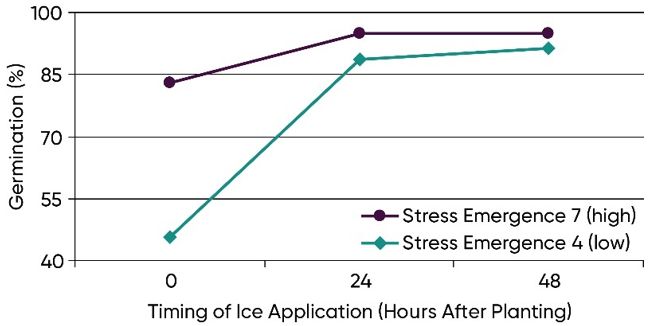
Figure 7. Germination of two hybrids with stress emergence scores of 7 (above average) and 4 (below average) following imbibitional chilling induced by melting ice. Ice was applied immediately after planting (0 hours) or after 24 hours or 48 hours of pre-germination in warm conditions.
Planting just before a stress event such as a cold rain or snow can cause significant stand loss. The chances of establishing a good stand are greatly improved if seeds are able to germinate at least one day in warmer, moist conditions before a cold-stress event. Also, choosing a hybrid with a higher stress emergence score can help moderate stand losses due to cold stress.
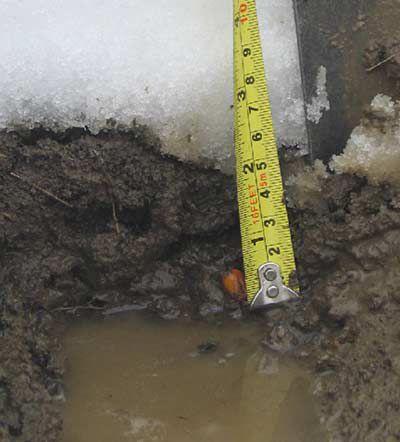
Snowfall soon after planting imposes a very high level of stress on corn emergence due to seed imbibing chilled water or prolonged exposure to cold, saturated soils.
One reason why temperature during imbibition is critical to corn emergence is the fact that seed imbibes most of the water needed for germination very rapidly. To illustrate the rapid timing of water uptake, seed was submerged in 50°F water for 3 hours and weighed at intervals of 30, 60, 120 and 180 minutes to determine water uptake (Figure 8).
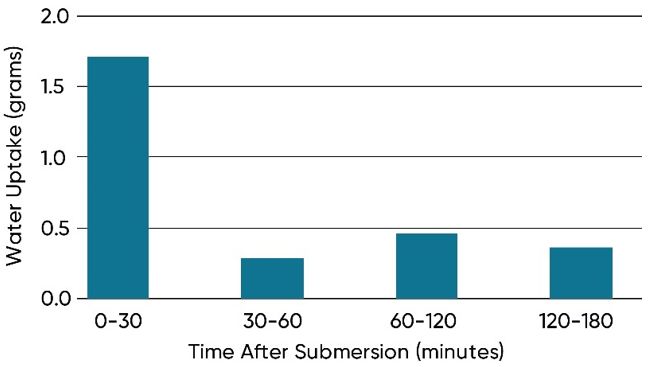
Figure 8. Amount of water uptake by corn seed during the first three hours after submersion in 50°F water.
The data show that seed imbibes the most water within the first 30 minutes after exposure to saturated conditions. If this early imbibition occurs at cold temperatures, it could kill the seed or result in abnormal seedlings. Growers should not only consider soil temperature at planting, but also the expected temperature when seed begins rapidly soaking up water. Seed planted in warmer, dry soils can still be injured if the dry period is followed by a cold, wet event.
Farmers are often able to plant fields with sandier soils earlier in the spring because they dry out faster than heavier soils. However, reduced stands after early planting have often been noted in sandier soils. Sandy soils are more porous and have lower water holding capacity than heavier soils. As such, they tend to experience wider temperature fluctuations, especially on clear nights with cold air temperatures.

Seedling injury caused by temperature fluctuations.
In 2015, soil temperatures were recorded at a 2-inch depth at a research location with sandy soils near Eau Claire, WI. Daytime soil temperatures reached acceptable levels for corn development (over 50°F) for the first week after planting. However, the early morning soil temperatures dipped to as low as 38°F, and on some days the soil temperature difference between 6 AM and 6 PM was over 20°F (Figure 9). An average 16% stand loss was observed at this location, suggesting that day-night temperature fluctuation after planting can cause added stress to germinating corn. Farmers should be aware of expected night temperatures when choosing a planting date.
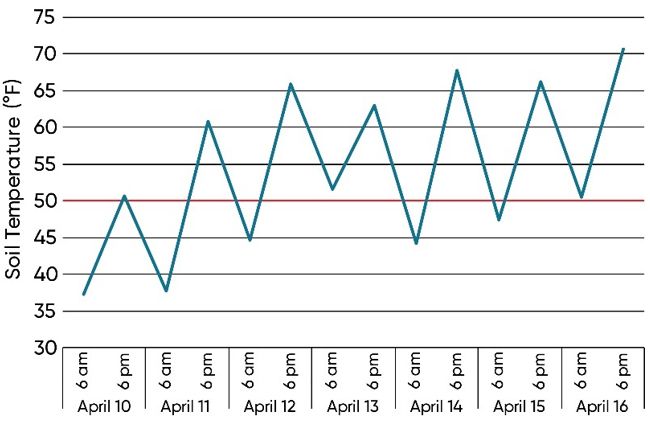
Figure 9. Soil temperatures at 6:00 am and 6:00 pm for seven days after planting in a stress emergence field location near Eau Claire, WI in 2015.
Another factor to consider when choosing planting date is the amount of residue in the field. High amounts of residue can present management challenges. Residue tends to hold excess water and significantly lower soil temperature in the spring, depriving seed of critical heat units needed for rapid emergence. These conditions can also promote seedling disease, particularly in fields that are not well drained or have a history of seedling blights.
In 2011, soil temperature data loggers were placed in a field near Perry, IA to assess early soil temperatures in a strip-till field. One data logger was placed in the tilled planting strip (low residue) and one was placed in between the rows under high residue. Soil GDUs were calculated from the data logger temperatures to approximate how long emergence would take under low and high residue conditions. In general, approximately 125 soil GDUs are needed after planting for corn emergence. From April 1 to April 30, soils under low residue were able to accumulate 99 soil GDUs. During the same timeframe, neighboring soils under heavy residue accumulated only 28 soil GDUs.
In mid-April 2019, a 15-degree midday temperature difference was noted in the same field between soil under low residue and soil ~20 yards away under soybean residue (Figure 10). Using a row cleaner to clear residue off the row in high residue fields allows for warmer daytime soil temperatures and faster GDU accumulation.
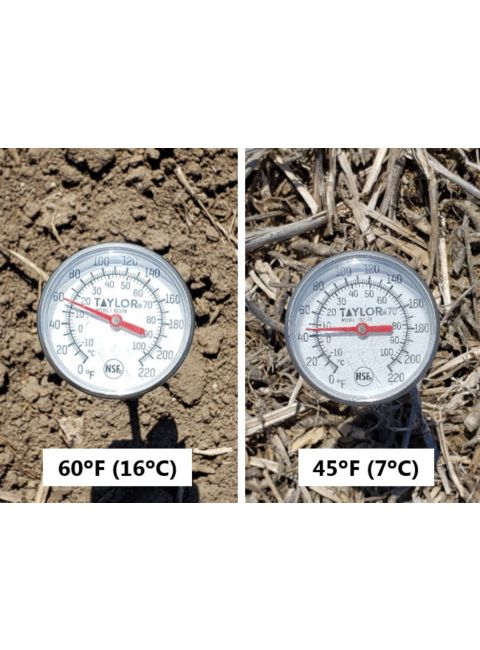
Figure 10. A 15-degree temperature difference was observed midday on April 15, 2019 in a central Iowa field between soil under no residue and soil under heavy residue.
Stress emergence is an agronomic trait intended to reflect genetic variability for tolerance to abiotic stress in the early season. It is not a rating for disease resistance. Early season stress can promote seedling disease if certain conditions are met, including inoculum presence and prolonged cool, wet conditions. Injury to emerging seedlings will also promote seedling disease. Injury can be caused by chilling, such as imbibitional damage, or by feeding of insects such as seedcorn maggots, white grubs, and wireworms.
In environments with heavy inoculum pressure, disease progression is often in a race with seedling growth. Conditions that promote rapid soil warming will generally favor seedling growth and reduce disease incidence. On the other hand, extended cool, wet conditions will generally favor disease progression.
Many soil pathogens, including some Pythium species, are most active at temperatures in the 40s and 50s (ºF). Low temperatures such as these can injure emerging seedlings and facilitate infection. Low temperatures also impede stand establishment and increase the window of vulnerability to infection. Fungicide seed treatments generally provide good efficacy against target organisms for 10 to 14 days after planting. However, protection will be diminished if emergence and stand establishment are delayed beyond this period.
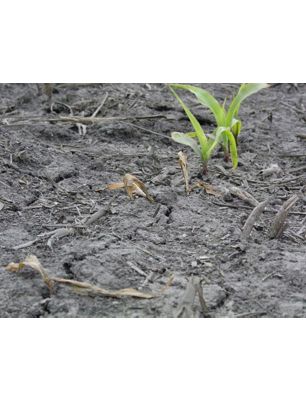
Corn plants at approximately the V2 growth stage dying from seedling disease. This field encountered cold conditions and saturated soils after planting.
Delayed emergence due to cold, wet conditions lengthens the duration during which seed and seedlings are most vulnerable to early season insects and diseases. Seed treatments can help protect stands from both disease and insect pests. For more information on seed treatment options for Pioneer® brand corn products, contact your local Pioneer sales professional or visit www.pioneer.com.
Planting date is one of the most important factors in stand establishment. The likelihood of reduced stands is greatest when planting in to cold, wet soils or directly before cold, wet weather is expected. To help mitigate risk, consider the following tips:
The Authors acknowledge Erin Anderson and Beth Merrill for their contributions to the corn stress emergence research summarized in this article.
The foregoing is provided for informational use only. Please contact your Pioneer sales professional for information and suggestions specific to your operation. Product performance is variable and depends on many factors such as moisture and heat stress, soil type, management practices and environmental stress as well as disease and pest pressures. Individual results may vary.
PIONEER® brand products are provided subject to the terms and conditions of purchase which are part of the labeling and purchase documents.